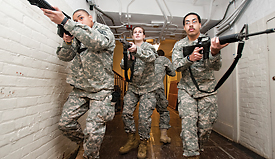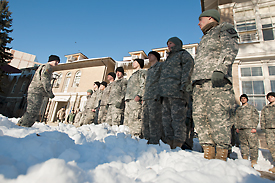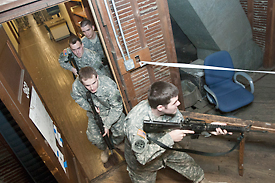Army ROTC senior Erika Sprinkle remembers the day she “grew brave enough” to approach one of the military recruiters she would see at her high school in Flint.
“From the moment I spoke with a recruiter, I knew I was going to the military right after,” she says.

Army ROTC cadets Lorne Carter, Stephanie Kennedy and Roman Motley join in a training exercise on campus. Army cadets also have the opportunity to join training exercises at Fort Custer, Mich., and Fort Lewis, Wash. Photos by Eric Bronson, U-M Photo Services.
However, Sprinkle thought she might defer that dream and stick to an earlier plan to apply to U-M. She was accepted — and soon was delighted to learn there is an Army Reserve Officers’ Training Corps (ROTC) program on campus. “I signed up and have been here ever since,” says Sprinkle, who is training to be an Army nurse.
Nationally, ROTC applications are up as public support for the military has grown since Sept. 11, 2001, ROTC officials say. Sprinkle is among roughly 311 U-M based ROTC cadets on campus representing three branches of the service: the Army, Navy and Air Force.
“Interest in the program is skyrocketing,” says Capt. Richard Vanden Heuvel, commander of the U-M-based Navy Officer Education Program, which has 106 cadets, 21 of them women and about one-third from Eastern Michigan University.
In this period of economic downturn, a sure job in the military upon graduation could be an attraction. Yet, Vanden Heuvel says, “Very rarely does the economy come up when cadets talk about why they joined. It’s service; it’s about giving back.”


Above, Army ROTC cadets line up outside North Hall, where U-M’s Army, Navy and Air Force ROTC programs share office space and jointly perform some tri-service events. Below, Jonathan Krause, Evan Redmond, Erin Amundson and Taylor Allen, all Army ROTC cadets, perform a room clearing exercise at North Hall.
Lt. Col. Lisa Franz, Air Force ROTC commander, says, “They want to serve in the Air Force, and to serve something greater than themselves.” Roughly 115 Air Force ROTC cadets are based at U-M; Seventy-five percent are U-M students and the remaining 25 percent are students at area colleges.
GI Jobs magazine has placed U-M-Ann Arbor on its 2011 Military Friendly Schools list, ranking it in the top 15 percent of universities, colleges and trade schools nationwide for services to veterans provided through the university’s Student Veterans Assistance Program located within the Office of New Student Programs.
Army Lt. Colonel Jan Malaikal, chair of the Army Officer Education Program, which has 90 cadets including students from the Ann Arbor campus, UM-Dearborn, UM-Flint and Wayne State University, says ROTC’s popularity is increasing for many reasons. “Some of the factors probably include our increased recruiting efforts, both at U-M-Ann Arbor, as well as at Wayne State. Another factor is possibly the economy, where students are looking at options to fund school, which ROTC can assist with.”
Malaikal says there are other incentives. “Cadets often mention that they like the challenges that ROTC offers,” she says. “Army ROTC pushes cadets out of their comfort zone in order to help them fulfill their potential. We do this through physical challenges — rappelling, weapons training, physical fitness training and leadership challenges.”
But Malaikal agrees that cadets ultimately join ROTC to serve their country. “That currently means that they will most likely serve in combat,” she says.
U-M’s Army, Navy and Air Force ROTC programs share office space in North Hall and jointly perform some tri-service events. “We work together quite often to share resources,” Malaikal says. Their program requirements also generally are comparable.
The Army way
In Army ROTC, cadets take military science courses each semester to develop military and leadership skills, participate in a weekly two-hour leadership lab and participate three times per week in physical fitness training.
Each semester Army cadets join a 48-hour Field Training Exercise at Fort Custer outside Battle Creek. Between their junior and senior year of college, all Army cadets go to Fort Lewis, Wash., for a 30-day Leadership Development and Assessment Course with other cadets from across the nation.
“There are optional training opportunities for cadets to attend airborne and air assault schools, to do internships in foreign countries, and to be a leader in an Army unit over their summer breaks as well,” Malaikal says. During their senior year, Army cadets essentially run all Army ROTC training.
Army ROTC students are required to wear the Army combat uniform for the leadership labs and field training exercises, and the Army Class A dress uniform for any official event, such as flag details and color guard. All ROTC cadets can live anywhere on campus.
“The most satisfying thing about Army ROTC is that although we are training to be officers, our career (education) is always the primary focus,” Sprinkle says. Each weekday, she devotes six-to-10 hours to classes and two-to-four hours to ROTC. Friends who aren’t in ROTC remark on her commitment, dedication and motivation to being a cadet — although Sprinkle admits it’s sometimes tough to get up early in the morning for training sessions.
Leadership instruction and service
Keeping up with new technology is essential for those in ROTC programs. “The Naval program requires midshipmen to take calculus and calculus-based physics regardless of the major, because the systems they will be using in the fleet require that understanding,” Vanden Heuvel says.
Through ROTC training, cadets are expected to develop a leadership style, and an ability to make effective and ethical decisions, he adds.
Within weeks of graduation, a Navy ROTC cadet can expect to be serving on a ship or submarine, or attending flight school, depending on their career field. Of spring Air Force ROTC graduates, Franz says most entered intensive pilot training, or trained as acquisitions managers, procuring and maintaining weapons systems from the newest F-22 fighter to legacy aircraft including the C-130 and B-52.
Vanessa Risedorph, a recent architecture major, was among Navy ROTC cadets sworn into the service by President Barack Obama at spring 2010 commencement. Now an ensign, she reported for flight training as a Student Naval Flight Officer at the beginning of September.
“Sometimes finding an appropriate balance between classes and NROTC was extremely difficult,” she says. “As an architecture student, it’s pretty much expected that you’ll have late nights working on projects. As a NROTC midshipman, much of our training each week is conducted in the early morning. Sleep, for me, was sometimes a rare commodity, but it paid off in the end.”

